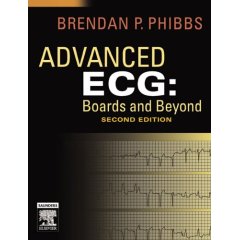Book Description
ECGs make up a significant part of the internal medicine and
cardiology specialty board exams, and this is the perfect book to
help you prepare. In this comprehensive volume, Dr Phibbs explains
how to differentiate among ECG rhythms and describes the identifying
principles of commonly confused rhythm readings. Pearls and tips for
recognizing rhythm problems and common pitfalls in ECG readings
appear in every chapter and are covered in detail. In addition, three
practice exams with a total of over 100 questions facilitate exam
preparation and self-assessment. * Provides extensive examples of all
common and uncommon arrhythmias for easy recognition. * Contains over
100 board-type review questions with answers and strategies for
passing the arrhythmia section. * Uses simple line drawings of
anatomical structures to promote a greater understanding of
arrhythmia and how functional problems manifest as rhythm disorders.
* Utilizes clear explanations of rhythm function to enables quick
understanding of difficult concepts * Incorporates pearls and tips to
help you decipher ECGs and identify important markings on the
readings.
Book Info
Covers the fundamentals of electrocardiography for physicians.
Illustrated with more than 450 ECG strips and rhythms. Softbound.
DNLM: Electrocardiography. --This text refers to an out of print or
unavailable edition of this title.
Advanced ECG: Boards and Beyond
TABLE OF CONTENTS
1. Sinus Rhythms: Two Benign Variations
2. Ectopic Beats and Sustained Ectopic Rhythms: Mechanisms of Idiorhythms and
Paroxysmal Tachycardia
3. Differential Diagnosis of Wide-Beat Tachycardia
4. The Supraventricular Tachycardias
5. Various Abnormalities of Intraventricular Conduction
6. More About Aberrancy
Self-Assessment I
7. AV Block: Where Is It Localized and What Do You Do About It?
8. Diagnosis of Complex Forms of AV Block: Some Tricks, Some Booby Traps
9. Atrial Fibrillation
10. Atrial Flutter
Self-Assessment II
11. Preexcitation
12. Fascicular Beats and Fascicular Tachycardia
13. Concealed Conduction, Exit Block, Bundle-Branch Wenckebach and Supernormal
Conduction
14. Fatal Arrhythmias: Ventricular Fibrillation, Ventricular Flutter, Torsade,
R-on-T Phenomenon, Standstill
15. The Sick Sinus Syndrome
16. Digitalis-Toxic Arrhythmias
17. Myocardial Infarction
18. Diagnosing Myocardial Infarction in the Presence of Bundle-Branch Block
19. Transient Myocardial Ischemia and Angina Pectoris
20. Pericarditis
21. Enlargement of the Chambers of the Heart: Hypertrophy and Dilatation
22. "Nonspecific" Myocardial Pathology
23. Electrolytes and Drugs
24. Two Special Cases: Pulmonary Emboli and Hypothermia
Self-Assessment Exercise III
25. Graduation Exercise
26. How to Take a Board Examination
Appendixes
I. Indications for Pacing in the Bradyarrhythmias
II. How to Determine Axis


